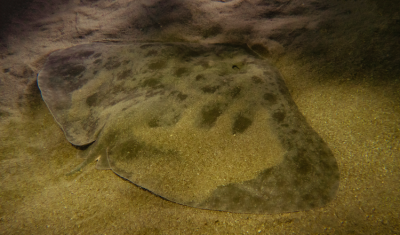The coastal waters of the Pacific are full of sharks, and Birch Aquarium is home to several of these species. Each plays a vital role in their environment and has unique adaptations that allow them to fill highly specialized niches. From the iconic Leopard Shark to the more mysterious Pacific Angel Shark, keep reading to learn more about these fascinating animals.

Leopard Shark
If you’re local to La Jolla, chances are you’ve heard about or even seen a Leopard Shark! These local legends stand out thanks to their distinctive “saddle” pattern. They are one of the most commonly observed local shark species – each summer, hundreds of pregnant females migrate to the shallow waters of San Diego, like the protected waters of the Matlahuayl State Marine Reserve, to give birth. Leopard Sharks are ovoviviparous, which means their eggs develop inside the female shark’s body and then they give birth to live young after a 10 - 12 month gestation. At Birch Aquarium, our Leopard Sharks receive annual physicals, where we can monitor their health and learn more about their care.

Swell Shark
Swell Sharks are small sharks that make their home on the rocky floor of kelp forests along the California coast. Their mottled spots allow them to easily blend into their surroundings. Ever heard of the term “mermaid’s purse”? That’s another name for the egg case of a Swell Shark! These rubbery cases have coiled tendrils at the corners, which help them attach to rocks and seaweed, anchoring them securely. Swell Sharks’ common name comes from a unique ability – when threatened, they ‘swell’ in size by bending into a U-shape to pump air or water into their stomach. This transforms the relatively small shark to appear nearly double its size, warding off predators. After the danger clears, swell sharks release the water or air, returning to their normal proportions.

Gray Smoothhound Shark
Gray Smoothhound Sharks are found over continental shelves in the eastern Pacific Ocean from northern California to the Gulf of California, and are sometimes even seen schooling with Leopard Sharks! These slender sharks have prominent snouts and blunt teeth, allowing them to easily munch on hardshell mollusks and crustaceans along the ocean floor. Like Leopard Sharks, Gray Smoothhound Sharks are ovoviviparous and give birth to live young after a 10 - 11 month gestation period.
Pacific Angel Shark
Though this bottom-dwelling creature’s flattened appearance might initially suggest it’s a ray, it is, in fact, a shark! The Pacific Angel Sharks is an especially unique shark species due to its flattened features, sandy brown coloration and scattered spots. An ambush predator, this shark hunts by camouflaging itself on the ocean floors of kelp forests or rocky reefs, often waiting for prey beneath a layer of sand. When the time is right they’ll lunge forward, open their mouths wide and extend their powerful jaws to suction up their prey in a blink of an eye. Celebrated on June 26, International Angel Shark Day highlights the importance of this endangered species and how we can better protect this special shark.

Horn Shark
Horn Sharks are small bottom-dwelling sharks found along the California coast. These brownish-gray sharks are covered in small black spots, with distinctive spines on their dorsal fins that give them their name. Horn Sharks are known for their unique spiral-shaped egg cases, which females lay in rocky crevices where they hatch six to nine months later. They reside in shallow rocky reefs and eat small fish and invertebrates such as mollusks and crustaceans.

Bat Ray
Bat Rays swim by gracefully flapping their batlike wings in the water and can be found on sandy ocean floors near kelp forests. These rays employ some unique techniques when hunting for food! They flap their strong fins to disturb sand, exposing prey such as mollusks and clams and use their large snout to dig into the sand to find food. Bat Rays give birth to live young, which are born tail first with their wide wings rolled around their bodies like tiny burritos! Like all sharks and rays, Bat Rays are covered in dermal denticles, which are tooth-like scales covering their entire bodies. The barb at the base of a Bat Ray’s tail is actually a modified dermal denticle!

California Butterfly Ray
The California Butterfly Ray is one of the more elusive local species of stingrays, and are found near California and Mexico, including the Gulf of California. Butterfly Rays are distinctively shaped, with wingspan twice as wide as their bodies and a light spotted pattern that helps them hide on sandy ocean floors. These elegant underwater butterflies can be found in various coastal waters, like estuarine waters, intertidal marshes, and coastal lagoons. The females are usually larger than the males and they give birth to live young.

Round Ray
The Round Ray is one of the most common rays that can be found off the California coast. Typically found in sandy seafloors, they migrate to shallow bays during their breeding season. They come in various shades of brown and gray, sometimes having a plain or mottled pattern on their body, perfect for blending into their surroundings. Round Rays are small, about the size of a frisbee, and like to hide by burying themselves in the sand with only their eyes exposed. This is why beachgoers are often advised to “shuffle” their feet as they walk in the water, so as not to accidentally step on a small, well-camouflaged ray.
Through the SAFE Sharks & Rays program, over 60 organizations, including Birch Aquarium, are working to protect sharks from the environmental threats they face including overfishing and warming oceans. To learn more about shark and ray conservation, and how you can get involved in protecting these amazing creatures, visit AZA SAFE: Shark and Ray.